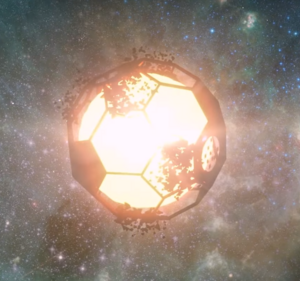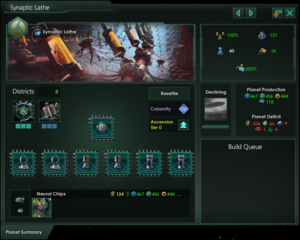Megastructures
Megastructures are colossal constructions. Expensive and time-consuming to build or repair, these remarkable feats of engineering are nonetheless important wonders that provide large bonuses, demonstrating the technological and economic primacy of the builders' empire. They cannot be built in orbit of a celestial object that has an uninvestigated anomaly. All megastructures except ![]() Gateways are destroyed if a Star-Eater destroys the system and cannot be restored after.
Gateways are destroyed if a Star-Eater destroys the system and cannot be restored after.
ConstructionEdit
All megastructures require a construction ship for their initial stage; later stages do not. Many megastructures have different visual textures depending on the ship appearance of the empire that built or restored them.
Each stage of a megastructure has a required time to build measured in days. By default, construction progress is equal to 1 per day. The following factors modify this, generally increasing the rate such as progress might be 1.5, 2, or even more per day. Thus, a megastructure stage that requires 3600 days (10 years) can be completed in fewer than 3600 days.
FTL megastructuresEdit
FTL megastructures can only be constructed at the edge of a system and allow fleets to traverse to an identical megastructure, greatly easing travel across the galaxy. They work together with the FTL megastructures of another empire unless borders are closed or the empires are at war with each other. FTL megastructures can be constructed in any system which doesn't already have that type of megastructure. They can also be dismantled if the empire has the technology to build them and is at peace. Unlike other megastructures, they can be constructed in the systems of subjects as well.
GatewaysEdit
While exploring the galaxy, empires may find abandoned ![]() gateways that were once part of a massive, galaxy-spanning network. The number of abandoned gateways can be scaled or disabled by galaxy settings. Note that even if gateways are disabled, at least one gateway will exist in the galaxy if any empire has the
gateways that were once part of a massive, galaxy-spanning network. The number of abandoned gateways can be scaled or disabled by galaxy settings. Note that even if gateways are disabled, at least one gateway will exist in the galaxy if any empire has the ![]() Galactic Doorstep or
Galactic Doorstep or ![]() Imperial Fiefdom origin.
Imperial Fiefdom origin.
Once an abandoned gateway is discovered, the ![]() Gateway Activation technology can be drawn; this technology allows abandoned gateways to be repaired. Repairing an abandoned gateway takes 2 years and costs
Gateway Activation technology can be drawn; this technology allows abandoned gateways to be repaired. Repairing an abandoned gateway takes 2 years and costs ![]() 6000 energy and
6000 energy and ![]() 2500 alloys. When a gateway is activated for the first time in the galaxy, another random gateway is also activated along with it.
2500 alloys. When a gateway is activated for the first time in the galaxy, another random gateway is also activated along with it.
Once the ![]() Gateway Activation technology is researched, the
Gateway Activation technology is researched, the ![]() Gateway Construction technology can appear, which allows new gateways to be constructed. Gateway construction first requires a construction ship to build a gateway site, which must be located outside of the system's gravity well. The gateway site takes 3 years to complete and costs
Gateway Construction technology can appear, which allows new gateways to be constructed. Gateway construction first requires a construction ship to build a gateway site, which must be located outside of the system's gravity well. The gateway site takes 3 years to complete and costs ![]() 75 influence and
75 influence and ![]() 2500 alloys; this occupies the construction ship throughout the process. Once the site is complete, upgrading to a fully functional Gateway takes another 5 years and costs
2500 alloys; this occupies the construction ship throughout the process. Once the site is complete, upgrading to a fully functional Gateway takes another 5 years and costs ![]() 6000 energy and
6000 energy and ![]() 2500 alloys, but this does not require a construction ship.
2500 alloys, but this does not require a construction ship.
Gateways allow travel to any other gateway instantly, so long as the borders are open and the destination is not controlled by an enemy empire. As a bypass, Gateways generally act like a hyperlane connection between systems, such that claims and trade can be extended through them, however sectors do not extend through gateways. Dismantling a gateway costs ![]() 2500 Energy and takes 1 year.
2500 Energy and takes 1 year.
|
|
Available only with the Galactic Paragons DLC enabled. |
Repairing any gateway has a 20% chance to discover the legendary paragon, Skrand Sharpbeak; this chance increases to 50% on subsequent repairs or if the planet Skravird has been discovered. If the empire has the ![]() Galactic Doorstep origin, the chance is 33% for the first gateway and 67% for subsequent gateways or if Skravird has been discovered.
Galactic Doorstep origin, the chance is 33% for the first gateway and 67% for subsequent gateways or if Skravird has been discovered.
- L-Gates
|
|
Available only with the Distant Stars DLC enabled. |
![]() L-gates are a special type of gateway, with a separate network from regular gateways. Instead of jumping from any to any, L-Gates all jump to the Terminal Egress system in the L-Cluster, then from there to any other L-Gate, so long as that system's borders are open or the fleet's owner is at war with the system's owner. L-Gates are opened through a special project, and new L-Gates cannot be constructed.
L-gates are a special type of gateway, with a separate network from regular gateways. Instead of jumping from any to any, L-Gates all jump to the Terminal Egress system in the L-Cluster, then from there to any other L-Gate, so long as that system's borders are open or the fleet's owner is at war with the system's owner. L-Gates are opened through a special project, and new L-Gates cannot be constructed.
Hyper RelaysEdit
|
|
Available only with the Overlord DLC enabled. |
Hyper Relays can grant additional effects based on ![]() edicts and subject specializations. Hyper Relay edicts require the empire's capital system to be part of the network, while the benefits granted by subject specializations require a connection between the overlord's capital and the subject's capital. Subjects do not benefit from their overlord's network effects.
edicts and subject specializations. Hyper Relay edicts require the empire's capital system to be part of the network, while the benefits granted by subject specializations require a connection between the overlord's capital and the subject's capital. Subjects do not benefit from their overlord's network effects.
Hyper Relays can be built from the galaxy view, which places them semi-randomly within the system. In systems with ![]() wormholes or existing
wormholes or existing ![]() gateways, it is recommended to instead go into the system view to manually place the Hyper Relay near to the wormhole or gateway to better facilitate travel, as Hyper Relays do not connect through wormholes or gateways.
gateways, it is recommended to instead go into the system view to manually place the Hyper Relay near to the wormhole or gateway to better facilitate travel, as Hyper Relays do not connect through wormholes or gateways.
HabitatsEdit
Habitats are colonizable megastructures that can be built above stars or planets and are finished in a single stage. Each system can only have one habitat. Building a habitat requires the ![]() Orbital Habitats technology, costs
Orbital Habitats technology, costs ![]() 200 Influence and
200 Influence and ![]() 1500 Alloys and takes 5 years to construct. The habitat still requires colonization, but the colony develops twice as fast as on planets. Habitats cannot be built in systems with a ring world, above moons, or above celestial objects with another megastructure.
1500 Alloys and takes 5 years to construct. The habitat still requires colonization, but the colony develops twice as fast as on planets. Habitats cannot be built in systems with a ring world, above moons, or above celestial objects with another megastructure.
The maximum number of districts that a habitat can have is 0.25 per planet or star in the system for each habitat tier. The maximum number for each type of resource district depends on the ![]() Energy,
Energy, ![]() Minerals and
Minerals and ![]() Research deposits in the system (deposits of unity and rare resources count as research for this purpose). Each deposit grants (1 + half of its value) districts, rounded down. Each time a resource district is constructed it creates an orbital on a celestial body with its resource if any is still available, replacing any existing mining or research station. Orbitals are identical in effects and upkeep to mining and research stations but cannot be attacked by fleets. Habitats do not have planetary features with the exception of a few unique habitats.
Research deposits in the system (deposits of unity and rare resources count as research for this purpose). Each deposit grants (1 + half of its value) districts, rounded down. Each time a resource district is constructed it creates an orbital on a celestial body with its resource if any is still available, replacing any existing mining or research station. Orbitals are identical in effects and upkeep to mining and research stations but cannot be attacked by fleets. Habitats do not have planetary features with the exception of a few unique habitats.
Only ![]() Gestalt Consciousness,
Gestalt Consciousness, ![]() Void Dwellers or empires with the
Void Dwellers or empires with the ![]() Voidborne ascension perk can construct housing buildings on habitats.
Voidborne ascension perk can construct housing buildings on habitats.
Habitats are shown in one of three tiers in the outliner, depending on the level of the capital building.
The following unlock the ability to build habitats:
 If the Utopia DLC is active, any empire can research the technologies to construct and upgrade habitats.
If the Utopia DLC is active, any empire can research the technologies to construct and upgrade habitats. Empires with the
Empires with the  Void Dwellers origin start with a habitat and the technology to build more. They can research the technology to upgrade them from the start.
Void Dwellers origin start with a habitat and the technology to build more. They can research the technology to upgrade them from the start. Empires with the
Empires with the  Knights of the Toxic God origin start with a habitat. They can research the technology to build more from the start but cannot research the technology to upgrade them without the
Knights of the Toxic God origin start with a habitat. They can research the technology to build more from the start but cannot research the technology to upgrade them without the  Utopia DLC.
Utopia DLC. Empires with the
Empires with the  Payback origin can gain a unique size 10 habitat called Recovered Asset as one of their two choices following the conclusion of the The Aftermath of Battle archaeological site. Choosing the habitat unlocks the technology to build more but cannot research the technology to upgrade them without the
Payback origin can gain a unique size 10 habitat called Recovered Asset as one of their two choices following the conclusion of the The Aftermath of Battle archaeological site. Choosing the habitat unlocks the technology to build more but cannot research the technology to upgrade them without the  Utopia DLC.
Utopia DLC. If the Apocalypse DLC is active, empires created by the Horde breaking up start with the technology to construct habitats. These habitats can be captured by other empires.
If the Apocalypse DLC is active, empires created by the Horde breaking up start with the technology to construct habitats. These habitats can be captured by other empires.
Habitats can otherwise be obtained in the following ways:
- The Federation's End unique system can randomly spawn, containing two habitats. The system does not require any DLC to spawn but does not contain enough celestial objects to support districts.
 If the First Contact DLC is active, the Ithome cluster has a 25% chance to spawn. The Ithome's Gate system contains 3 habitats. Each habitat has a unique modifier granting it max
If the First Contact DLC is active, the Ithome cluster has a 25% chance to spawn. The Ithome's Gate system contains 3 habitats. Each habitat has a unique modifier granting it max  Habitability and +8
Habitability and +8  Reactor, Mining or Research districts.
Reactor, Mining or Research districts. If the Cosmic Storms DLC is active, a habitat can be obtained by completing the Hold the Line archaeological site.
If the Cosmic Storms DLC is active, a habitat can be obtained by completing the Hold the Line archaeological site.
Habitat Central Complexes can be ruined by a colossus or crises. If ruined, all orbitals are destroyed.
Deep space citadelsEdit
Deep space citadels are large defensive stations that can contain certain starbase buildings and can support defense platforms. Similar to a starbase, when a deep space citadel runs out of hull points it is occupied if the attacker was an empire and destroyed if the attacker was a crisis or using the Existential Expulsion casus belli.
Normally only Fallen Empire systems have deep space citadels, but if the ![]() BioGenesis DLC is enabled all empires can research the technology to construct their own. Deep space citadels can be constructed anywhere in a system. Each system can have one deep space citadel, and the number is increased by one for each of the following:
BioGenesis DLC is enabled all empires can research the technology to construct their own. Deep space citadels can be constructed anywhere in a system. Each system can have one deep space citadel, and the number is increased by one for each of the following:
Deep space citadels are designed in the ship designer and when constructing or upgrading one there will be a prompt to choose which design to use. Their cost is not affected by the installed components. Deep space citadels come in three tiers. They are constructed at tier I and then upgraded. Deep space citadels can have their design changed if the empire has the technology to build them but the current construction or upgrade cost much be paid again.
| Tier | Buildings | Weapon slots | Utility slots | Mechanical cost | Biological cost | Build time |
|---|---|---|---|---|---|---|
| I | 1 | 3 years | ||||
| II | 2 | 3 years | ||||
| III | 4 | 4 years |
Orbital ringsEdit
|
|
Available only with the Overlord DLC enabled. |
Half megastructure and half starbase, orbital rings can be built around colonized planets to act as an additional starbase in the system or provide useful bonuses for the planet below. They do not require a construction site and are finished in a single stage by the construction ship. Tier 2 and 3 are upgraded similarly to starbases without the need for a construction ship. Orbital rings also have ![]() +100% fire rate.
+100% fire rate.
Ruined Orbital Rings can be rebuilt at a cost of ![]() 500 alloys and
500 alloys and ![]() 50 influence and 2 years of construction time. This does not require a construction ship. A ruined Orbital Ring can be discovered in a random binary system.
50 influence and 2 years of construction time. This does not require a construction ship. A ruined Orbital Ring can be discovered in a random binary system.
ModulesEdit
Orbital Rings use their own set of modules, which are mostly similar to Starbase modules except that they do not interact with trade routes in any way. An Orbital Assembly Complex holding on the planet provides additional bonuses to each module.
Fleet modulesEdit
Fleet modules allow the orbital ring to construct fleets. Multiple fleet modules may be constructed to produce multiple ships or space fauna in parallel but only one type of fleet module can be constructed on an orbital ring. Each fleet module costs 50 ![]() alloys, takes
alloys, takes ![]() 180 days to construct and has an
180 days to construct and has an ![]() energy upkeep of 1 unit per month. Each fleet module can produce two ships or space fauna at a time instead of one if an Orbital Assembly Complex is constructed on the planet.
energy upkeep of 1 unit per month. Each fleet module can produce two ships or space fauna at a time instead of one if an Orbital Assembly Complex is constructed on the planet.
Defense modulesEdit
Defense modules increase the orbital ring's effectiveness in combat and allow for the construction of additional defense platforms. Each defense module costs 50 ![]() alloys, takes
alloys, takes ![]() 180 days to construct and has an
180 days to construct and has an ![]() energy upkeep of 1 unit per month.
energy upkeep of 1 unit per month.
BuildingsEdit
In addition to most of the regular starbase buildings, Orbital Rings can construct a set of buildings that improve the planet's output. All of them take ![]() 360 days to build.
360 days to build.
Planetary building replacementsEdit
The following orbital ring buildings fulfill the same function as certain planet buildings. They have the same requirements to construct and cannot be built if the matching building has been constructed on the planet.
Multi-stage megastructuresEdit
Multi-stage megastructures are constructed in multiple stages that require the technology with the same name before they can be constructed. Empires lacking the technology can make use of a multi-stage megastructure which they conquered from another empire, but they cannot upgrade it before they research the prerequisite technology.
Multi-stage megastructures start with a construction site that provides no benefit. However, each subsequent construction phase brings increasing bonuses, culminating with the end of the megastructure construction.
Only one multi-stage megastructure may be built in each system. Multi-stage megastructures must be built either over an uninhabitable planet or a star. There must not be an anomaly present on the planet or star, but an anomaly on another planet or star in the system does not block construction.
Each empire can build build, upgrade, or restore only one multi-stage megastructure at a time. This limit is increased by the following factors:
| Megastructure construction limit | |
|---|---|
| Source | Effect |
| +1 | |
| +1 | |
| +1 | |
| +1 | |
Most multi-stage megastructures are limited in how many times they may be built. An empire with the ![]() Isolated Contingency Core relic can build an additional megastructure of each type. If an empire loses a limited megastructure, it cannot build another of that type. Megastructures obtained through conquest and ruined ones that were found in the galaxy and repaired do not count against this limit. A conquered incomplete megastructure can still be upgraded as long as the new owner has the prerequisite technology.
Isolated Contingency Core relic can build an additional megastructure of each type. If an empire loses a limited megastructure, it cannot build another of that type. Megastructures obtained through conquest and ruined ones that were found in the galaxy and repaired do not count against this limit. A conquered incomplete megastructure can still be upgraded as long as the new owner has the prerequisite technology.
| Megastructure | Stage | Production | Upkeep | Mechanical cost | Biological cost | Notes | Limit | DLC | |
|---|---|---|---|---|---|---|---|---|---|
Science Nexus
|
Site | None | 5 years |
|
1 | ||||
| Stage I (Hub) |
10 years | ||||||||
| Stage II (Research Wings) |
10 years | ||||||||
| Stage III (Completed) |
10 years | ||||||||
| Stage IV (Groik Nexus) |
Event | ||||||||
Sentry Array
|
Site | None | 5 years |
|
1 | ||||
| Stage I (Sentry Hub) |
5 years | ||||||||
| Stage II (Sentry Spire) |
5 years | ||||||||
| Stage III (Sentry Aerials) |
5 years | ||||||||
| Stage IV (Completed) |
5 years | ||||||||
Ring World
|
Site | None | 5 years |
|
0 | ||||
| Stage I (Frame) | None | None | 13.3 years | ||||||
| Stage II (1 Segment) | None | 10 years | |||||||
| Stage III (2 Segments) | None | 10 years | |||||||
| Stage IV (3 Segments) | None | 10 years | |||||||
| Stage V (Completed) | None | 10 years | |||||||
Mega Art Installation
|
Site | None | 5 years | 1 | |||||
| Stage I (Nascency) |
10 years | ||||||||
| Stage II (Maturity) |
10 years | ||||||||
| Stage III (Completed) |
10 years | ||||||||
| Stage IV (Perfection) |
10 years | ||||||||
Strategic Coordination Center
|
Site | None | 5 years | 1 | |||||
| Stage I (Hull) |
10 years | ||||||||
| Stage II (Comms) |
10 years | ||||||||
| Stage III (Completed) |
10 years | ||||||||
Interstellar Assembly
|
Site | None | 5 years |
|
1 | ||||
| Stage I (Locus) |
5 years | ||||||||
| Stage II (Consul Ring) |
5 years | ||||||||
| Stage III (Forum Modules) |
5 years | ||||||||
| Stage IV (Completed) |
5 years | ||||||||
Matter Decompressor
|
Site | None | 5 years |
|
1 | ||||
| Stage I (Anchor) | 10 years | ||||||||
| Stage II (Lensing) | 10 years | ||||||||
| Stage III (Boring) | 10 years | ||||||||
| Stage IV (Completed) | 10 years | ||||||||
Mega Shipyard
|
Site | None | 5 years |
|
1 | ||||
| Stage I (Framework) |
5 years | ||||||||
| Stage II (Core) |
5 years | ||||||||
| Stage III (Complete) |
5 years | ||||||||
Quantum Catapult
|
Site | None | 5 years |
|
0 | ||||
| Stage I (Single Array) |
5 years | ||||||||
| Stage II (Twin Arrays) |
5 years | ||||||||
| Stage III (Complete) |
5 years | ||||||||
(Twin Arrays) |
10 years |
| |||||||
(Complete) |
10 years | ||||||||
Arc Furnace
|
Stage I (Equatorial Band) |
1 year |
|
3 | |||||
| Stage II (Borehole Pumps) |
3 years | ||||||||
| Stage III (Mohole Extractors) |
3 years | ||||||||
| Stage IV (Completed) |
3 years | ||||||||
Dyson Swarms and Dyson SphereEdit
The Dyson Swarms and the Dyson Sphere are two megastructures the construction of which may be linked depending on which DLCs are enabled. Neither megastructure can be constructed in binary or trinary systems or around pulsars, neutron stars or black holes.
- If the
 The Machine Age DLC is enabled, Dyson Swarms can be constructed after researching the
The Machine Age DLC is enabled, Dyson Swarms can be constructed after researching the  Dyson Swarm technology
Dyson Swarm technology - If the
 Utopia DLC is enabled, a Dyson Sphere can be built after taking the
Utopia DLC is enabled, a Dyson Sphere can be built after taking the  Galactic Wonders ascension perk and researching the
Galactic Wonders ascension perk and researching the  Dyson Sphere technology.
Dyson Sphere technology.
- If the
 The Machine Age DLC is not enabled, a Dyson Sphere is built from scratch, starting from Construction Site
The Machine Age DLC is not enabled, a Dyson Sphere is built from scratch, starting from Construction Site - If the
 The Machine Age DLC is enabled, a Dyson Sphere is built by upgrading a completed Dyson Swarm. It upgrades to Stage II (Initial), and inherits all effects of the Dyson Swarm.
The Machine Age DLC is enabled, a Dyson Sphere is built by upgrading a completed Dyson Swarm. It upgrades to Stage II (Initial), and inherits all effects of the Dyson Swarm. - A ruined Dyson Sphere is always restored to Stage V (Completed), and only requires the
 Mega-Engineering technology to restore.
Mega-Engineering technology to restore. - If the
 Nemesis DLC is enabled, a Dyson Sphere can be further upgraded as part of the Kaleidoscope situation.
Nemesis DLC is enabled, a Dyson Sphere can be further upgraded as part of the Kaleidoscope situation.
- If the
Discoverable Ring WorldsEdit
Up to 8 ringworlds can spawn naturally in a game in various states. Damaged segments can be repaired with the ![]() Mega-Engineering technology for the same cost as finishing a new segment.
Mega-Engineering technology for the same cost as finishing a new segment.
- One in the Sanctuary system. All 4 habitable sections are intact and each contains one pre-FTL civilization, none advanced beyond Steam Age. The system was abandoned by an Enigmatic Observer Fallen Empire but contains automated defense platforms totaling over 50k fleet power.
- One in the Cybrex Alpha system. It requires completing the Cybrex precursor event chain. The ringworld is completely ruined and requires repairs on each section.
- One in the Cybrex Beta system. It is only revealed if the Contingency sterilizes 20% of the galaxy. A short time after the Contingency is defeated, the Cybrex leave the galaxy, leaving the ringworld free for the taking.
- One in a random empty system if the
 Utopia DLC is enabled. It is completely ruined and each section requires repairing. If the
Utopia DLC is enabled. It is completely ruined and each section requires repairing. If the  Distant Stars DLC is enabled as well, the system has a 50% chance to contain a unique anomaly.
Distant Stars DLC is enabled as well, the system has a 50% chance to contain a unique anomaly. - Three in the systems of the Ancient Caretakers if the
 Synthetic Dawn DLC is enabled. The ringworld in the home system has three intact and one ruined section, while the other two ringworlds are completely ruined and require each section to be repaired separately. If the Contingency appears and the Ancient Caretakers awaken to defend the galaxy, they also disappear like the Cybrex once the Contingency is defeated, leaving their systems free for the taking.
Synthetic Dawn DLC is enabled. The ringworld in the home system has three intact and one ruined section, while the other two ringworlds are completely ruined and require each section to be repaired separately. If the Contingency appears and the Ancient Caretakers awaken to defend the galaxy, they also disappear like the Cybrex once the Contingency is defeated, leaving their systems free for the taking. - Each empire with the
 Shattered Ring origin starts in a ringworld system with 1-3 segments depending on the Guaranteed Habitable Worlds game rule. By default, only one empire with the origin can be generated, but force-spawning ignores that limit.
Shattered Ring origin starts in a ringworld system with 1-3 segments depending on the Guaranteed Habitable Worlds game rule. By default, only one empire with the origin can be generated, but force-spawning ignores that limit.
Ruined megastructuresEdit
Ruined versions of a multi-stage megastructure can be found while exploring the galaxy, with larger galaxies having a chance to spawn more ruined megastructures. Repairing them generally requires only the ![]() Mega-Engineering technology. If not yet researched, owning a system with a ruined megastructure also grants a ×20 weight for Mega-Engineering to appear. The following ruined megastructures cannot spawn unless the same DLC as is required to construct them is enabled.
Mega-Engineering technology. If not yet researched, owning a system with a ruined megastructure also grants a ×20 weight for Mega-Engineering to appear. The following ruined megastructures cannot spawn unless the same DLC as is required to construct them is enabled.
While they upgrade from their broken to a fully functional state in one step, they do not count for any achievements. However, they also do not count against any build limit for that particular megastructure either.
| Ruined Megastructure | Cost | Repair technology | System notes | DLC | |
|---|---|---|---|---|---|
| 20 years | |||||
| 13.3 years | |||||
| 13.3 years | Contains a |
||||
| 10 years | Contains deposits on most celestial objects | ||||
| 13.3 years | |||||
| 13.3 years | Is always a trinary system | ||||
| 13.3 years | |||||
| 10 years | |||||
| 10 years | Is always a pulsar system | ||||
| 10 years | Adjacent to homeworld of a |
||||
| 6 months | Found in the home system of the Yuht Empire precursors | ||||
| 2 years | Can be generated in the Ancient Mining Drones home system in addition to a random system |
Aetherophasic EngineEdit
|
|
Available only with the Nemesis DLC enabled. |
The Aetherophasic Engine is a megastructure that appears in the capital system of every empire that reaches the final Galactic Nemesis crisis level. Each stage of the megastructure requires gargantuan amounts of ![]() dark matter as well as 10 years to upgrade. If the system is conquered by another empire, the megastructure is ruined and can be repaired if the original empire reclaims it. Empires that reached the final crisis level and lost their Aetherophasic Engine but conquer another one have the option to take control of the new megastructure.
dark matter as well as 10 years to upgrade. If the system is conquered by another empire, the megastructure is ruined and can be repaired if the original empire reclaims it. Empires that reached the final crisis level and lost their Aetherophasic Engine but conquer another one have the option to take control of the new megastructure.
Synaptic LatheEdit
|
|
Available only with the The Machine Age DLC enabled. |
Constructing a Synaptic Lathe requires the ![]() Scalable Reservoir Computing technology, which is unlocked by the
Scalable Reservoir Computing technology, which is unlocked by the ![]() Cosmogenesis ascension perk. Only one Synaptic Lathe can be constructed. Constructing the megastructure requires 300
Cosmogenesis ascension perk. Only one Synaptic Lathe can be constructed. Constructing the megastructure requires 300 ![]() Influence and 15000
Influence and 15000 ![]() Alloys and takes 2400 days.
Alloys and takes 2400 days.
The Synaptic Lathe has many functions normally found only on planets. It has ![]() Stability,
Stability, ![]() Housing,
Housing, ![]() Amenities,
Amenities, ![]() Pops, a designation and ascension tier. It also has an
Pops, a designation and ascension tier. It also has an ![]() Efficiency value, which is increased by 5% for each pop. Low
Efficiency value, which is increased by 5% for each pop. Low ![]() Stability cannot create revolts but still affects job output. The Synaptic Lathe has its own set of buildings and districts and its appearance changes as the capital building is upgraded.
Stability cannot create revolts but still affects job output. The Synaptic Lathe has its own set of buildings and districts and its appearance changes as the capital building is upgraded.
All pops in a Synaptic Lathe have the ![]() Neural Chip job. Pops cannot grow on a Synaptic Lathe but they can be resettled even if the empire policy does not otherwise allow it. Pops in the Synaptic Lathe are purged over time regardless of species rights; the rate of the purge scales with the population of the Lathe. If the population drops to zero, the owner gets an event to either refill the Lathe with 100 pops, or let it break. The last pop cannot be resettled. Pops with the
Neural Chip job. Pops cannot grow on a Synaptic Lathe but they can be resettled even if the empire policy does not otherwise allow it. Pops in the Synaptic Lathe are purged over time regardless of species rights; the rate of the purge scales with the population of the Lathe. If the population drops to zero, the owner gets an event to either refill the Lathe with 100 pops, or let it break. The last pop cannot be resettled. Pops with the ![]() Virtual trait do not generate resources when placed in a Synaptic Lathe.
Virtual trait do not generate resources when placed in a Synaptic Lathe.
The Synaptic Lathe has no defenses and immediately surrenders if an enemy fleet enters orbit. The megastructure will be disabled if the occupying empire does not have the ![]() Cosmogenesis ascension perk. If the system is completely occupied, the megastructure is destroyed. The occupying empire will get the option to resettle half of the pops to the capital, gain 500-1000000
Cosmogenesis ascension perk. If the system is completely occupied, the megastructure is destroyed. The occupying empire will get the option to resettle half of the pops to the capital, gain 500-1000000 ![]() Research and −75 Decaying Opinion with every non-fallen empire, or do nothing. Empires with the
Research and −75 Decaying Opinion with every non-fallen empire, or do nothing. Empires with the ![]() Cosmogenesis ascension perk can choose to keep the megastructure instead.
Cosmogenesis ascension perk can choose to keep the megastructure instead.
Grand ArchiveEdit
|
|
Available only with the Grand Archive DLC enabled. |
If the starbase of the system housing the Grand Archive is dismantled, the megastructure is removed. The empire will be refunded 500 ![]() Alloys and all space fauna above the Vivarium Capacity is culled.
Alloys and all space fauna above the Vivarium Capacity is culled.
An empire can only have one Grand Archive. If a subject with a Grand Archive is integrated while the empire already has one, the subject's megastructure is removed. If a system housing a Grand Archive is conquered, the megastructure is destroyed and all space fauna above the Vivarium Capacity is released. The empire that conquered the system will steal one specimen from each category, or two if it has the ![]() Barbaric Despoilers civic. If
Barbaric Despoilers civic. If ![]() Ancient Relics is installed, it will also receive 100
Ancient Relics is installed, it will also receive 100 ![]() Minor Artifacts.
Minor Artifacts.
Behemoth megastructuresEdit
|
|
Available only with the BioGenesis DLC enabled. |
Behemoth megastructures are available to empires with the ![]() Behemoth Fury ascension perk and used to create Behemoths. Hatching them requires the crisis level 2.
Behemoth Fury ascension perk and used to create Behemoths. Hatching them requires the crisis level 2.
| Megastructure | Construction cost | Hatching cost | Hatchling |
|---|---|---|---|
| Behemoth Egg | Class I Behemoth | ||
| Behemoth Chrysalis (class II) | Fully fed class I Behemoth | Class II Behemoth | |
| Behemoth Chrysalis (class III) | Fully fed class II Behemoth | Class III Behemoth | |
| Behemoth Egg (strengthened) | Class I Behemoth | ||
| Behemoth Egg (rapid) | Size 32 fleet (ship size depends of the Egg Development policy) | ||
| Behemoth Egg (large) | Size 96 fleet (ship size depends of the Egg Development policy) |
Behemoth Egg megastructures are destroyed if an enraged Behemoth reaches them.
ReferencesEdit
- ↑ A restored Hyper Relay can be dismantled at no cost; this is likely a bug.
| Exploration | Exploration • FTL • Unique systems • L-Cluster • Pre-FTL species • Fallen empire • Spaceborne aliens • Enclaves • Guardians • Marauders • Caravaneers |
| Celestial bodies | Celestial body • Colonization • Planetary features • Planet modifiers |
| Discovery | Discovery • Anomaly • Archaeological site • Astral rift • Relics • Collection |
| Species | Species • Pop modification • Biological traits • Machine traits • Population • Species rights • Ethics |
| Leaders | Leader • Common leader traits • Commander traits • Official traits • Scientist traits • Paragons |
| Governance | Empire • Origin • Government • Civics • Council • Agendas • Policies • Edicts • Factions • Traditions • Ascension perks • Situations |
| Economy | Resources • Planetary management • Districts • Jobs • Designation • Trade • Megastructures |
| Buildings | Planet capital • Common buildings • Unique buildings • Holdings |
| Ships | Ship • Ship designer • Core components • Weapon components • Utility components • Mutations • Offensive mutations |
| Technology | Technology • Physics research • Society research • Engineering research |
| Diplomacy | Diplomacy • Relations • Galactic community • Federations • Subject empires • Intelligence • AI personalities |
| Warfare | Warfare • Space warfare • Land warfare • Starbase • Crisis |
| Others | Events • The Shroud • Preset empires • AI players • Stat modifiers • Console commands • Easter eggs |




































